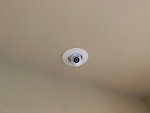- Nov 12, 2017
- 12,657
- Pool Size
- 12300
- Surface
- Plaster
- Chlorine
- Salt Water Generator
- SWG Type
- Pentair Intellichlor IC-40
It's rainy today, so I'm trapped inside. Why not hang out at TFP!?!
If anyone's been wondering why I've been mostly AWOL from TFP, here's the tale. In my defense, I did answer all my private messages, and even chimed in here and there as time permitted. And that's been the challenge, the time permitted. In addition to my two jobs, child care, elder care and taking care of my house and pool and myself (more elder care), I got into some massive home-improvement projects this past year.
Some of this is semi-pool-related, some maybe not, but most of it might be of interest to those who, like me, are in constant search of making their life a little bit better, and a little bit easier.
In no particular order...
SMALL ANIMAL DEFENSE SYSTEM
Since I moved here, I've been in a constant battle with the small animals that live just beyond my pool's fence. Little b's dig up my yard, eat my plants (and all my fruit). They even ate one of my trees!! Gophers mostly, but I've had run-ins with moles, squirrels, raccoons, possums, cats... you name it. I first tried traps (too much trouble), then poison (I know, I know). Both worked, kinda, but the problem was: killing small animals (the ethics of that aside) doesn't get rid of them. It just frees up their territory and dens for the next batch of relatives to move in! So a few years ago I got serious and put more than half of my plants in pots. That solved the problem for those plants (and it made for an interesting landscape look), but the other plants and trees were still susceptible, and that didn't stop the critters from digging up the yard, and eating an entire half of a beautiful lawn!
OK, so then I had to get really serious!! I had already purchased a large roll of stainless steel mesh (3/4" grid: 4' x 100'). I had intended to lay that under the lawn I was going to have to replace. But I realized that wouldn't solve all the gopher problems, only for the lawn. So I went back to the website I purchased the wire from, Gophers Limited, and studied their alternative solution. Gopher fence! So I bought even more wire and built one:
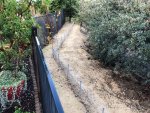
I hired a big guy and rented a Ditch Witch (those things are awesome!). What would have taken me weeks, and a trip to the hospital, he did in 45 minutes. He "witched" a 2' x 6" trench the entire width of my backyard, some 150' or so. I then laid in the pre-formed wire fencing (I can share how I did all this with anyone interested), and then installed the PVC supports. The wire (4' wide, remember) is bent in two places, to make a 6" shelf on top, and a 6" shelf on the bottom. This, theoretically, keeps animals from climbing over it, and gophers from burrowing under it. They generally tunnel about a foot deep, or crawl across the surface, so this fence is 12" above ground, and 24" below. If they try to go underneath, they hit the bottom shelf and give up. (I hope!)
But I wasn't convinced that would work against raccoons (who took out an entire planting bed one night), so I mounted two electric shock wires above the gopher fence, threaded through the PVC uprights. That runs 24-7. Hard to see in the pics, but one is close enough to the top shelf to deter small animals, and the other is at the top of the posts to keep larger critters from stepping over.
Problems solved!!! (So far...) All summer and fall: animal free. No lost plants. No dug-up yard. And no killing of animals (including no dead gophers and moles in the pool skimmer). Might sound like overkill, but it was worth it to me. Not to mention I lost about 10 lbs installing it!!
REWIRED BACK YARD
As I continue to expand my electrical system in my backyard, I had to finally admit I'd been doing it wrong. I was using extension cords, mostly, and they kept growing in length and quantity. All buried under mulch, or running on top of the dirt behind my pool fence. Easy to run, yes. Safe... not really. So I ripped it all out and laid down proper conduit, running from my junction box to three waterproof outlets. Each of the six plugs (2 per outlet x 3) is on a separate line, so I can control each thing plugged in separately, as they are all connected to my home automation (HA) controller. There are still some short extension cords to get from the outlets to the devices (like the fountain, or the bug zapper), some amount of that is unavoidable. But it's now much safer, and to code. It all runs off a GFI circuit, which is both properly grounded and bonded to the pool. I feel much better about all that now.
Here's the junction box where all the devices meet their HA controllers:
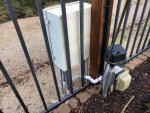
And one of the three waterproof outlets into which I plug everything:
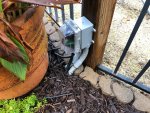
So far: fountain, bug zapper, pool light, citrus tree warmer, garden lights. Future plans include a second citrus tree and maybe some bistro lights on the pool fence.
Citrus tree heater (old-style incandescent Christmas lights):
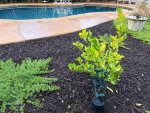
My near-future life might include some travel, a week or two at a time. Some of my projects were, in no small part, intended to make it possible for me to leave my house unattended for long stretches. I spent some coin when I first moved in on pool automation for that reason. And some of these next projects were inspired similarly.
LAWN REPLACEMENT
With one lawn half eaten, and the others giving me grief in terms of maintenance and expense, I decided to take them all out. I had four lawns. I liked looking at them, but nothing else about them. Plus, where I live, it seemed that they only looked good a few weeks a year, a few in the spring, the a few in the fall, otherwise: brown in the winter, brown in the summer! Not a particularly good ROI, for sure.
So, I called in the "big guy" again, and rented a sod cutter, and he and I proceeded to rip out the four lawns. Thanks to the cutter, that only took about a day. I waited a few weeks to make sure all the grass was gone, then I rented a one-man post hole digger and dug out about 40 holes: 12" deep, 12" around. I can't say enough about renting this "big" equipment. $100-$200 a pop, but worth every penny!! I dug those 40 holes in a few hours! And I did call 811 beforehand, to make sure I didn't strike gold! Glad I did, too. I kinda knew where my utilities ran, but I didn't realize the whole street's main power lines run under the front part of my property, right where I was digging holes!! Yikes.
I then filled those holes with amended soil, and planted about 120 small Myoporum plants (three in each hole). Myoporum is great: it eventually grows to about 9' in diameter, but doesn't re-root along the way, so you only have to water it at its original root, with drip, not sprinklers. And a whole lot less water than grass. And no mowing! It grows to about 4-6" thick, and then that's it. No trimming (except the edges). You can't play on it, but you can walk across it when you have to. Perfect for me and my family's lifestyle.
Here's two of the four new "lawns. The new plants on this first one are stretching out to meet the existing Myoporum the previous owners planted years ago. It's still looks good, and pretty green for December. That's how I knew it would be a good choice:
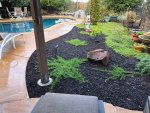

Not sure why some areas are growing so much faster than others, but eventually it'll all grow in and from not-too-far-away it'll look much like the lawns they replaced. Considering each bunch started out as one- or two-twig plants, they're doing pretty well. And they're evergreen, so they'll look much better year-round, way better than my lawns did, for sure.
Problem solved. Very little water, very little maintenance, and will definitely survive my one or two weeks away, without worry.
RECONFIGURED DRIP IRRIGATION
To accommodate the new "lawns," I took on a complete reconfiguration of my entire drip system. I added valves, ran drip to all the 40 new plantings, and ran more lines to better separate the other areas of my garden. Instead of just zones, I separated out plant types, to better fine tune their watering needs. So, for example, all the Myoporum is on a dedicated valve. My trees on another. All pots on a third. My redwood trees on yet another, etc. This way, I can dial in just what those plants need. The goal being to end up with healthier plants and a smaller water bill. In this last year I've already seen both.
Oh, and because I sent in the requisite photos and forms, the city paid me $500 and the state paid me $1500 to replace all that lawn. So, labor aside, the materials and rentals for the entire two projects, lawns and irrigation, were "free."
See Part 2...
If anyone's been wondering why I've been mostly AWOL from TFP, here's the tale. In my defense, I did answer all my private messages, and even chimed in here and there as time permitted. And that's been the challenge, the time permitted. In addition to my two jobs, child care, elder care and taking care of my house and pool and myself (more elder care), I got into some massive home-improvement projects this past year.
Some of this is semi-pool-related, some maybe not, but most of it might be of interest to those who, like me, are in constant search of making their life a little bit better, and a little bit easier.
In no particular order...
SMALL ANIMAL DEFENSE SYSTEM
Since I moved here, I've been in a constant battle with the small animals that live just beyond my pool's fence. Little b's dig up my yard, eat my plants (and all my fruit). They even ate one of my trees!! Gophers mostly, but I've had run-ins with moles, squirrels, raccoons, possums, cats... you name it. I first tried traps (too much trouble), then poison (I know, I know). Both worked, kinda, but the problem was: killing small animals (the ethics of that aside) doesn't get rid of them. It just frees up their territory and dens for the next batch of relatives to move in! So a few years ago I got serious and put more than half of my plants in pots. That solved the problem for those plants (and it made for an interesting landscape look), but the other plants and trees were still susceptible, and that didn't stop the critters from digging up the yard, and eating an entire half of a beautiful lawn!
OK, so then I had to get really serious!! I had already purchased a large roll of stainless steel mesh (3/4" grid: 4' x 100'). I had intended to lay that under the lawn I was going to have to replace. But I realized that wouldn't solve all the gopher problems, only for the lawn. So I went back to the website I purchased the wire from, Gophers Limited, and studied their alternative solution. Gopher fence! So I bought even more wire and built one:

I hired a big guy and rented a Ditch Witch (those things are awesome!). What would have taken me weeks, and a trip to the hospital, he did in 45 minutes. He "witched" a 2' x 6" trench the entire width of my backyard, some 150' or so. I then laid in the pre-formed wire fencing (I can share how I did all this with anyone interested), and then installed the PVC supports. The wire (4' wide, remember) is bent in two places, to make a 6" shelf on top, and a 6" shelf on the bottom. This, theoretically, keeps animals from climbing over it, and gophers from burrowing under it. They generally tunnel about a foot deep, or crawl across the surface, so this fence is 12" above ground, and 24" below. If they try to go underneath, they hit the bottom shelf and give up. (I hope!)
But I wasn't convinced that would work against raccoons (who took out an entire planting bed one night), so I mounted two electric shock wires above the gopher fence, threaded through the PVC uprights. That runs 24-7. Hard to see in the pics, but one is close enough to the top shelf to deter small animals, and the other is at the top of the posts to keep larger critters from stepping over.
Problems solved!!! (So far...) All summer and fall: animal free. No lost plants. No dug-up yard. And no killing of animals (including no dead gophers and moles in the pool skimmer). Might sound like overkill, but it was worth it to me. Not to mention I lost about 10 lbs installing it!!
REWIRED BACK YARD
As I continue to expand my electrical system in my backyard, I had to finally admit I'd been doing it wrong. I was using extension cords, mostly, and they kept growing in length and quantity. All buried under mulch, or running on top of the dirt behind my pool fence. Easy to run, yes. Safe... not really. So I ripped it all out and laid down proper conduit, running from my junction box to three waterproof outlets. Each of the six plugs (2 per outlet x 3) is on a separate line, so I can control each thing plugged in separately, as they are all connected to my home automation (HA) controller. There are still some short extension cords to get from the outlets to the devices (like the fountain, or the bug zapper), some amount of that is unavoidable. But it's now much safer, and to code. It all runs off a GFI circuit, which is both properly grounded and bonded to the pool. I feel much better about all that now.
Here's the junction box where all the devices meet their HA controllers:

And one of the three waterproof outlets into which I plug everything:

So far: fountain, bug zapper, pool light, citrus tree warmer, garden lights. Future plans include a second citrus tree and maybe some bistro lights on the pool fence.
Citrus tree heater (old-style incandescent Christmas lights):

My near-future life might include some travel, a week or two at a time. Some of my projects were, in no small part, intended to make it possible for me to leave my house unattended for long stretches. I spent some coin when I first moved in on pool automation for that reason. And some of these next projects were inspired similarly.
LAWN REPLACEMENT
With one lawn half eaten, and the others giving me grief in terms of maintenance and expense, I decided to take them all out. I had four lawns. I liked looking at them, but nothing else about them. Plus, where I live, it seemed that they only looked good a few weeks a year, a few in the spring, the a few in the fall, otherwise: brown in the winter, brown in the summer! Not a particularly good ROI, for sure.
So, I called in the "big guy" again, and rented a sod cutter, and he and I proceeded to rip out the four lawns. Thanks to the cutter, that only took about a day. I waited a few weeks to make sure all the grass was gone, then I rented a one-man post hole digger and dug out about 40 holes: 12" deep, 12" around. I can't say enough about renting this "big" equipment. $100-$200 a pop, but worth every penny!! I dug those 40 holes in a few hours! And I did call 811 beforehand, to make sure I didn't strike gold! Glad I did, too. I kinda knew where my utilities ran, but I didn't realize the whole street's main power lines run under the front part of my property, right where I was digging holes!! Yikes.
I then filled those holes with amended soil, and planted about 120 small Myoporum plants (three in each hole). Myoporum is great: it eventually grows to about 9' in diameter, but doesn't re-root along the way, so you only have to water it at its original root, with drip, not sprinklers. And a whole lot less water than grass. And no mowing! It grows to about 4-6" thick, and then that's it. No trimming (except the edges). You can't play on it, but you can walk across it when you have to. Perfect for me and my family's lifestyle.
Here's two of the four new "lawns. The new plants on this first one are stretching out to meet the existing Myoporum the previous owners planted years ago. It's still looks good, and pretty green for December. That's how I knew it would be a good choice:


Not sure why some areas are growing so much faster than others, but eventually it'll all grow in and from not-too-far-away it'll look much like the lawns they replaced. Considering each bunch started out as one- or two-twig plants, they're doing pretty well. And they're evergreen, so they'll look much better year-round, way better than my lawns did, for sure.
Problem solved. Very little water, very little maintenance, and will definitely survive my one or two weeks away, without worry.
RECONFIGURED DRIP IRRIGATION
To accommodate the new "lawns," I took on a complete reconfiguration of my entire drip system. I added valves, ran drip to all the 40 new plantings, and ran more lines to better separate the other areas of my garden. Instead of just zones, I separated out plant types, to better fine tune their watering needs. So, for example, all the Myoporum is on a dedicated valve. My trees on another. All pots on a third. My redwood trees on yet another, etc. This way, I can dial in just what those plants need. The goal being to end up with healthier plants and a smaller water bill. In this last year I've already seen both.
Oh, and because I sent in the requisite photos and forms, the city paid me $500 and the state paid me $1500 to replace all that lawn. So, labor aside, the materials and rentals for the entire two projects, lawns and irrigation, were "free."
See Part 2...
Last edited:


